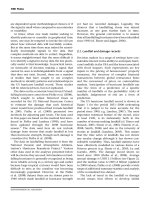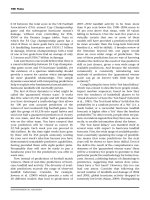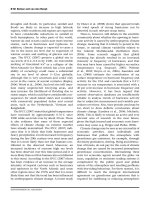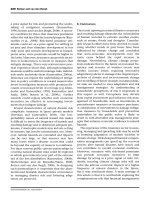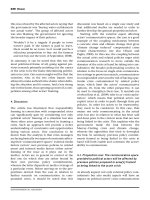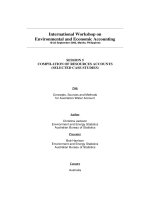Climate change as environmental and economic hazard - phần 2.3
Bạn đang xem bản rút gọn của tài liệu. Xem và tải ngay bản đầy đủ của tài liệu tại đây (98.16 KB, 8 trang )
a price signal for risk and promoting the under-
taking of mitigation measures (Kunreuther,
1996; Botzen and van den Bergh, 2008). A necess-
ary condition for this is that insurance premiums
reflect the risk faced by the insured property (Kun-
reuther et al., 2008). Risk-based insurance pre-
miums could act as a price signal for settling in
an area and thus stimulate development in less
risky areas and restrain development in hazard-
prone areas, since premiums would be higher in
the latter. Moreover, insurance can provide incen-
tives to homeowners to invest in measures that
mitigate damage. This is very relevant since prac-
tical experience shows that, although mitigation
measures could be useful to manage risks, individ-
uals rarely undertake them (Kunreuther, 2006a).
Insurance can require the undertaking of mitiga-
tion in policy conditions or reward insured who
invest in mitigation measures with premium dis-
counts or increased levels of coverage (e.g. Klein-
dorfer and Kunreuther, 1999; Kunreuther and
Pauly, 2006; Botzen et al., 2009c). Further
research could explore whether such economic
incentives are effective in encouraging invest-
ments that mitigate damage.
Several characteristics of natural disaster risk
complicate insurance in (pure) private markets
(Freeman and Kunreuther, 2003). The low-
probability nature of natural hazard risk makes
it difficult to assess the frequency of hazards and
resulting damage and to determine adequate pre-
miums. Catastrophe models may aid rate setting
by insurers, but involve uncertainties, too. More-
over, natural hazards are correlated and impacts
can be very large, so that insurees may face
many losses when a disaster occurs that could
be beyond the capacity of insurers to reimburse.
For these reasons public–private partnerships in
covering natural disaster risks could be explored
in which governments cover part of the extreme
tail of the loss distribution (Kunreuther, 2006b;
Michel-Kerjan and de Marcellis-Warin, 2006;
Botzen and van den Bergh, 2008). In designing
such partnerships it is important that the afore-
mentioned desirable characteristics of insurance
in managing disaster risk and fostering adap-
tation are preserved.
6. Conclusions
The recent upswing in natural disaster occurrence
and resulting damage illustrates the vulnerability
of human societies to extreme weather events,
such as storms, floods and droughts. Consider-
able research efforts have been devoted to exam-
ining whether trends in past losses have been
influenced by climate change and concluded
that socio-economic developments were the
main cause behind the rapid increase in
damage. Nevertheless, climate change projec-
tions indicate that in the future an increased fre-
quency and severity of weather events may
further increase losses, requiring innovative
adaptation policies to manage risks. Regional pro-
jections of climate and socio-economic change
and modelling of future changes in natural disas-
ter risks are needed to steer adaptation and risk
management strategies. An understanding of
households’ perceptions of risk is important in
this respect as well. Perceptions may deviate
from expert assessments and influence risk man-
agement of households, such as investments in
precautionary measures or insurance purchases.
A combination of investments in damage mitiga-
tion measures by households and prevention
undertaken by the public sector is likely to
result in well-diversified risk management strat-
egies that enhance economic resilience to natural
hazards.
The experience of the insurance sector in asses-
sing, managing and spreading risks may be useful
in fostering adaptation of modern societies to
climate change. Well-designed financial compen-
sation arrangements can speed up the recovery
process after natural disasters have struck and
can contribute to overall economic resilience.
Moreover, insurance with risk-based premiums
can provide economic incentives to limit
damage by acting as a price signal of risks. Evi-
dently, insuring climate change risks will not
solve the adverse economic impacts of a higher
frequency of natural disasters in the future,
but it may ameliorate them. A main message of
this article is that it is worthwhile exploring the
complementary role that financial arrangements
220 Botzen and van den Bergh
ENVIRONMENTAL HAZARDS
can play in designing comprehensive climate
change adaptation policies that comprise risk
prevention, reduction and efficient risk-sharing
strategies.
Acknowledgements
We thank Laurens Bouwer and Boris Profiriev for
helpful comments on this paper. This research
project was carried out as part of the Dutch
National Research Programme ‘Climate Changes
Spatial Planning’ (www.klimaatvoorruimte.nl).
The usual disclaimer applies.
Notes
1. The largest property insurer of Florida, State Farm,
announced on 27 January 2009 that it will not
renew its property insurances in the state, and
halted all sales. This announcement followed the
disapproval by regulators of a proposed premium
increase by State Farm of 47 per cent to cover
increased hurricane risks (www.statefarm.com).
2. Some authors argue that effects of catastrophes are
minor in macroeconomic terms, even though natural
catastrophes have considerable local impacts (Albala-
Bertrand, 2006).
3. Deforestation may also increase the vulnerability to
disasters caused by climate change, for example,
because of soil erosion and landslides resulting
from more frequent and severe rains and floods.
4. The surface mass balance of the Greenland Ice Sheet
may turn negative at a global average warming larger
than 1.9–4.6ºC, which could result in its complete
elimination over a very long time period (IPCC,
2007).
5. In this study it is assumed that no preventative
measures will be undertaken to highlight the relative
importance of socio-economic vs. climate change
(Aerts et al., 2008a).
6. The insurance sector is here broadly defined as com-
prising both primary insurers and reinsurance com-
panies. Reinsurance companies, such Munich Re
and Swiss Re, are often the ‘last resort’ carriers of cat-
astrophe risk. Potential effects of climate change are
likely to be passed on from reinsurance companies to
primary insurers in the form of higher reinsurance
prices or reduced reinsurance coverage.
References
Aerts, J. C. J. H. and Botzen, W. J. W., 2009. The delta
plan of the Netherlands: past and future perspectives
on flood risk protection. Against the Deluge: Storm
Surge Barriers to Protect New York City. Conference Pro-
ceedings, Polytechnic Institute of New York Univer-
sity, Brooklyn, NY.
Aerts, J. C. J. H., Sprong, T. and Bannink, B., 2008a. Aan-
dacht voor Veiligheid. Vrije Universiteit Amsterdam,
Amsterdam.
Aerts, J., Botzen, W. J. W., van der Veen, A., Krywkow, J.
and Werners, S., 2008b. Dealing with uncertainty in
flood management through diversification. Ecology
and Society, 13(1). 41.
Akter, S., Brouwer, R., Choudhury, S. and Aziz, S., 2009.
Is there a commercially viable market for crop insur-
ance in rural Bangladesh? Mitigation and Adaptation
Strategies for Global Change, 14(3). 215–229.
Albala-Bertrand, J. M., 2006. The Unlikeliness of an Econ-
omic Catastrophe: Localization and Globalization.
Working Paper No. 576. Queen Mary College, Uni-
versity of London, London.
Boc
ˇ
karjova, M., 2007. Major Disasters in Modern Econom-
ies: An Input–Output Based Approach at Modelling
Imbalances and Disproportions. Doctoral dissertation,
University of Twente, Enschede.
Botzen, W. J. W. and van den Bergh, J. C. J. M., 2008.
Insurance against climate change and flooding in
the Netherlands: present, future and comparison
with other countries. Risk Analysis, 28(2). 413–426.
Botzen, W. J. W. and van den Bergh, J. C. J. M., 2009a.
Bounded rationality, climate risks and insurance: is
there a market for natural disasters? Land Economics,
85(2). 266 –279.
Botzen, W. J. W. and van den Bergh, J. C. J. M., 2009b.
Monetary valuation of insurance against climate
change risk, submitted.
Botzen, W. J. W., Gowdy, J. M. and van den Bergh,
J. C. J. M., 2008. Cumulative CO
2
emissions: shifting
international responsibilities for climate debt.
Climate Policy, 8. 569–576.
Botzen, W. J. W., van den Bergh, J. C. J. M. and Bouwer,
L. M., 2009a. Climate change and increased risk for
the insurance sector: a global perspective and an
assessment for the Netherlands. Natural Hazards,
forthcoming.
Botzen, W. J. W., Bouwer, L. M. and van den Bergh,
J. C. J. M., 2009b. Climate change and hailstorm
damage: empirical evidence and implications for
agriculture and insurance, forthcoming.
Botzen, W. J. W., Aerts, J. C. J. H. and van den Bergh,
J. C. J. M., 2009c. Willingness of homeowners to
Managing natural disaster risks 221
ENVIRONMENTAL HAZARDS
mitigate climate risk through insurance. Ecological
Economics, 68(8 –9). 2265 –2277.
Botzen, W. J. W., Aerts, J. C. J. H. and van den Bergh,
J. C. J. M., 2009d. Dependence of flood risk percep-
tions on socio-economic and objective risk factors.
Water Resources Research, forthcoming.
Bouwer, L. M., Crompton, R. P., Faust, E., Ho
¨
ppe, P. and
Pielke Jr., R.A., 2007. Confronting disaster losses.
Science, 318(5851). 753.
Bouwer, L. M., Bubeck, P. and Aerts, J. C. J. H., 2009.
Future Flood Risk Estimates in a Dutch Polder Area.
Working manuscript. Institute for Environmental
Studies, Vrije Universiteit, Amsterdam.
Burn, D. H., 1999. Perceptions of flood risk: a case study
of the Red River flood of 1997. Water Resources
Research, 35(11). 3451 – 3458.
Camerer, C., 1998. Bounded rationality in individual
decision making. Experimental Economics, 1(2).
163–183.
Changnon, S. A., 2003. Shifting economic impacts from
weather extremes in the United States: a result of
societal changes, not global warming. Natural
Hazards, 29(2). 273 – 290.
Crompton, R. P. and McAneney, K. J., 2008. Normalised
Australian insured losses from meteorological
hazards: 1967–2006. Environmental Science & Policy,
11(5). 371 –378.
de Bruijn, K. M. and Klijn, F., 2001. Resilient flood risk
management strategies. Proceedings of the IAHR Con-
gress 2001, L. Guifen and L. Wenxue (eds). Tsinghua
University Press, Beijing.
de Bruijn, K. M., Green, C., Johnson, C. and McFadden,
L., 2007. Evolving concepts in flood risk manage-
ment: searching for a common language. Flood Risk
Management in Europe: Innovation in Policy and Prac-
tice, S. Begum, M. J. F. Stive and J. W. Hall (eds).
Springer, Dordrecht.
de Moel, H., van Alphen, J. and Aerts, J. C. J. H., 2009.
Flood maps in Europe – methods, availability and
use. Natural Hazards and Earth System Sciences, 9(2).
289–301.
Dlugolecki, A. F., 2000. Climate change and the insur-
ance industry. The Geneva Papers on Risk and Insur-
ance – Issues and Practice, 25(4). 582–601.
Dlugolecki, A. F., 2008. Climate change and the insur-
ance sector. The Geneva Papers on Risk and Insurance –
Issues and Practice, 33(1). 71–90.
Downton, M. W. and Pielke, R. A., 2001. Discretion
without accountability: politics, flood damage and
climate. Natural Hazards Review, 2(4). 157–166.
Elsner, J. B., Kossin, J. P. and Jagger, T. H., 2008. The
increasing intensity of the strongest tropical
cyclones. Nature, 455(7209). 92–95.
Emanuel, K., 2005. Increasing destructiveness of tropi-
cal cyclones over the past 30 years. Nature,
436(7051). 686 –688.
Finucane, M. L., Alhakami, A., Slovic, P. and Johnson,
S. M., 2000. The affect heuristic in judgements of
risks and benefits. Journal of Behavioral Decision
Making, 13. 1–17.
Flynn, J., Slovic, P., Mertz, C. K. and Carlisle, C., 1999.
Public support for earthquake risk mitigation in Port-
land, Oregon. Risk Analysis, 19(2). 205–216.
Freeman, P. K. and Kunreuther, H., 2003. Managing
environmental risk through insurance. The Inter-
national Yearbook of Environmental and Resource Econ-
omics 2003/2004, H. Folmer and T. Tietenberg (eds).
Edward Elgar Publishing, Northampton, UK.
Freeman, P. K., Keen, M. and Mani, M., 2003. Dealing
with Increased Risk of Natural Disasters: Challenges
and Options. IMF Working Paper WP/03/197. Inter-
national Monetary Fund, Washington, DC.
Godschalk, D., 2003. Urban hazard mitigation: creating
resilient cities. Natural Hazards Review, 4(3). 136–143.
Grossi, P. and Kunreuther, H. C., 2005. Catastrophe
Mod-
eling:
A New Approach of Managing Risk. Springer,
New York.
Handmer, J. W. and Dovers, S. R., 1996. A typology of
resilience: rethinking institutions for sustainable
development. Organization & Environment, 9(4).
482–511.
Heimann, M. and Reichstein, M., 2008. Terrestrial eco-
system, carbon dynamics and climate feedbacks.
Nature, 451(7176). 289 – 292.
Hoff, H., Warner, K. and Bouwer, L. M., 2005. The role of
financial services in climate adaptation in develop-
ing countries. Vierteljahrshefte zur Wirtschafts-
forschung, 74(2). 196– 207.
Holling, C. S., 1973. Resilience and stability of ecologi-
cal systems. Annual Review of Ecology and Systematics,
4(1). 1 – 23.
Holling, C. S., 1986. The resilience of terrestrial ecosys-
tems: local surprise and global change. Sustainable
Development of the Biosphere, W. C. Clark and R. E.
Munn (eds). Cambridge University Press, Cam-
bridge, UK.
Ho
¨
ppe, P. and Pielke, R., 2006. Report of the Workshop
on Climate Change and Disaster Losses, October.
Hohenkammer, Germany.
Hoyos, C. D., Agudelo, P. A., Webster, P. J. and Curry,
J. A., 2006. Deconvolution of the factors contribut-
ing to the increase in global hurricane intensity.
Science, 312(5769). 94 –97.
IFRC, 2001. World Disasters Report. International Fed-
eration of Red Cross and Red Crescent Societies,
Geneva.
222 Botzen and van den Bergh
ENVIRONMENTAL HAZARDS
IPCC (Intergovernmental Panel on Climate Change),
2007. Climate Change 2007: The Physical Science
Basis. Contribution of Working Group I to the Fourth
Assessment Report of the Intergovernmental Panel on
Climate Change. S. Solomon, D. Qin, M. Manning,
Z. Chen, M. Marquis, K. Averyt, M. M. B. Tignor
and H. L. Miller (eds). Cambridge University Press,
Cambridge and New York.
Janssen, L. H. J. M., Okker, V. R. and Schuur, J., 2006.
Welvaart en leefomgeving: een scenariostudie voor
Nederland in 2040. Achtergronddocument. Centraal
Planbureau, Milieu- en Natuurplanbureau and
Ruimtelijk Planbureau. www.welvaartenleefom
geving.nl/ (in Dutch).
Jonkman, S. N., Brinkhuis-Jak, M. and Kok, M., 2004.
Cost benefit analysis and flood damage mitigation
in the Netherlands. HERON, 49(1). 95–111.
Kahneman, D., 2003. Maps of bounded rationality: psy-
chology for behavioral economics. The American
Economic Review, 93(5). 1449–1475.
Kahneman, D. and Tversky, A., 1979. Prospect theory:
an analysis of decision under risk. Econometrica,
47(2). 263 –291.
Kahneman, D., Slovic, P. and Tversky, A., 1982. Judg-
ment under Uncertainty: Heuristics and Biases. Cam-
bridge University Press, New York.
Keller, C., Siegrist, M. and Gutscher, H., 2006. The role
of the affect and availability heuristics in risk com-
munication. Risk Analysis, 26(3). 631–639.
Kennedy, M., Mrofka, D. and von der Borch, C., 2008.
Snowball earth termination by destabilization of
equatorial permafrost methane clathrate. Nature,
453(7195). 642 –645.
Kerr, R. A., 2006. A tempestuous birth of hurricane cli-
matology. Science, 312(5774). 676 – 678.
Klein, R. J. T., Nicholls, R. J. and Thomalla, F., 2003. Resi-
lience to natural hazards: how useful is this concept?
Environmental Hazards, 5(1 –2). 35 – 45.
Kleindorfer, P. and Kunreuther, H. C., 1999. The comp-
lementary roles of mitigation and insurance in
managing catastrophic risks. Risk Analysis, 19(4).
721–732.
Kreibich, H., Thieken, A. H., Petrow, T., Mu
¨
ller, M. and
Merz, B., 2005. Flood loss reduction of private house-
holds due to building precautionary measures:
lessons learned from the Elbe flood in August 2002.
Natural Hazards and Earth System Sciences, 5(1).
117–126.
Kunreuther, H. C., 1996. Mitigating disaster losses
through insurance. Journal of Risk and Uncertainty,
12(2–3). 171–187.
Kunreuther, H. C., 2006a. Disaster mitigation and
insurance: learning from Katrina. Annals of the
American Academy of Political and Social Science,
604(1). 208 – 227.
Kunreuther, H. C., 2006b. Has the time come for
comprehensive natural disaster insurance? On
Risk and Disaster: Lessons from Hurricane Katrina,
R. J. Daniels, D. F. Kettl and H. Kunreuther (eds). Uni-
versity of Pennsylvania Press, Philadelphia, PA.
Kunreuther, H. C. and Michel-Kerjan, E. O., 2007.
Climate change, insurability of large-scale disasters,
and the emerging liability challenge. University of
Pennsylvania Law Review, 155(6). 1795–1842.
Kunreuther, H. C. and Pauly, M., 2006. Rules rather
than discretion: lessons from Hurricane Katrina.
Journal of Risk and Uncertainty, 33(1). 101–116.
Kunreuther, H. C., Michel-Kerjan, E. O., Doherty, N. A.,
Grace, M. F., Klein, R. W. and Pauly, M. V., 2008.
Managing Large-Scale Risks in a New Era of Cata-
strophes: Insuring, Mitigating and Financing Recovery
from Natural Disasters in the United States. Wharton
Risk Management and Decision Processes Center,
Georgia State University and Insurance Information
Institute, Philadelphia, PA.
Landsea, C. W., Harper, B. A., Hoarau, K. and Knaff, J. A.,
2006. Can we detect trends in extreme tropical
cyclones? Science, 313(5786). 452–454.
Lay, T., Kanamori, H., Ammon, C. J., Nettles, M., Ward,
S. N., Aster, R. C., Beck, S. L., Bilek, S. L., Brudzinski,
M. R., Butler, R., DeShon, H. R., Ekstro
¨
m, G., Satake,
K. and Sipkin, S., 2005. The great Sumatra–Andaman
earthquake of 26 December 2004. Science, 308(5725).
1127–1133.
Loewenstein, G. F., Hsee, C. K., Weber, E. U. and Welch,
N., 2001. Risk as feelings. Psychological
Bulletin,
127(2).
267–286.
Luechinger, S. and Raschky, P. A., 2009. Valuing flood
disasters using the life satisfaction approach.
Journal of Public Economics, 93(3–4). 620–632.
Mason, C. F., Shogren, J. F., Settle, C. and List, J. A.,
2005. Investigating risky choices over losses using
experimental data. Journal of Risk and Uncertainty,
31(2). 187 –215.
Merz, B., Kreibich, H., Thieken, A. H. and Schmidtke, R.,
2004. Estimation uncertainty of direct monetary
flood damage to buildings. Natural Hazards and
Earth System Sciences, 4(1). 153–163.
Michaels, P., 2006. Is the sky really falling? A review of
recent global warming scare stories. Policy Analysis,
576. 1 –25.
Michel-Kerjan, E. and de Marcellis-Warin, N., 2006.
Public–private programs for covering extreme
events: the impact of information distribution on
risk-sharing. Asia-Pacific Journal of Risk and Insurance,
1(2). 21 – 49.
Managing natural disaster risks 223
ENVIRONMENTAL HAZARDS
Michel-Kerjan, E. and Morlaye, F., 2008. Extreme
events, global warming, and insurance-linked securi-
ties: how to trigger the ‘tipping point’. Geneva Papers
on Risk and Insurance – Issues and Practice, 33(1). 153 –
176.
Miller, S., Muir-Wood, R. and Boissonnade, A., 2008.
An exploration of trends in normalized weather-
related catastrophe losses. Climate Extremes and
Society, H.F. Diaz and R.J. Murnane (eds). Cambridge
University Press, Cambridge, UK. 225–247.
Mills, E., 2005. Insurance in a climate of change. Science,
309(5737). 1040 –1044.
Mills, E., 2007. From Risk to Opportunity: 20072 Insurers
Responses to Climate Change. Ceres Report, October.
Ceres, Boston, MA.
Mills, E. and Lecomte, E., 2006. From Risk to Opportunity:
How Insurers Can Proactively and Profitably Manage
Climate Change. Ceres Report, August. Ceres,
Boston, MA.
Mills, E., Lecomte, E. and Peara, A., 2002. Insurers in the
greenhouse. Journal of Insurance Regulation, 21(1).
43–78.
Mitchell, R. C. and Carson, R. T., 1989. Using
Surveys to Value Public Goods: The Contingent Valua-
tion Method. Resources for the Future, Washington,
DC.
Muir-Wood, R., Miller, S. and Boissonade, A., 2006. The
search for trends in a global catalogue of normalized
weather-related catastrophe losses. Workshop on
Climate Change and Disaster Losses,P.Ho
¨
ppe and
R. A. Jr. Pielke, (eds). Hohenkammer, Germany.
Munich Re, 2009. Topics Geo Natural Catastrophes 2008:
Analyses, Assessments, Positions. Munich Re Group,
Munich.
Peacock, W. G., Brody, S. D. and Highfield, W., 2005.
Hurricane risk perceptions among Florida’s single
family homeowners. Landscape and Urban Planning,
73(2–3). 120–135.
Pelling, M., 2003. The Vulnerability of Cities: Natural Dis-
asters and Social Resilience. Earthscan, London.
Pielke, R. A., Prins, G., Rayner, S. and Sarewitz, D., 2007.
Lifting the taboo on adaptation. Nature, 445(7128).
597–598.
Pielke, R. A., Gratz, J., Landsea, C. W., Collins, D., Saun-
ders, M. and Musulin, R., 2008. Normalized hurri-
cane damages in the United States: 1900–2005.
Natural Hazards Review, 9. 29–42.
Pierrehumbert, R. T., 2004. Warming the world. Nature,
432(7018). 677.
Pimm, S. L., 1984. The complexity and stability of eco-
systems. Nature, 307(5949). 321–326.
Porfiriev, B., 2009. Community resilience and vulner-
ability to disasters: qualitative models and
megacities: a comparison with small towns. Environ-
mental Hazards, 8(1). 23–37.
Priest, G. L., 1996. The government, the market, and
the problem of catastrophic loss. Journal of Risk and
Uncertainty, 12(2–3). 219–237.
Quiggin, J., 1982. A note on the existence of a competi-
tive optimum. Economic Record, 55(161). 174–176.
Rapley, C., 2006. The Antarctic ice sheet and sea level
rise. Avoiding Dangerous Climate Change, H. J. Schelln-
huber, W. Cramer, N. Nakicenovic, T. Wigley and G.
Yohe (eds). Cambridge University Press, Cambridge,
UK.
Rose, A., 2003. A typology of economic disruptions.
50th Annual North American Meetings of the Regional
Science Association International. Philadelphia, PA.
Rose, A., 2004a. Defining and measuring economic resi-
lience to disasters.
Disaster Prevention and Manage-
ment,
13(4).
307–314.
Rose, A., 2004b. Economic principles, issues, and
research priorities in hazard loss estimation. Model-
ling Spatial and Economic Impacts of Disasters,Y.
Okuyama and S.E. Chang (eds). Springer-Verlag,
Berlin and New York.
Rose, A., 2006. Economic resilience to disasters: toward
a consistent and comprehensive formulation. Disas-
ter Resilience: An Integrated Approach, D. Paton and
D. M. Johnson (eds). Charles C. Thomas, New York.
Rose, A., 2007. Economic resilience to natural and
man-made disasters: multidisciplinary origins and
contextual dimensions. Environmental Hazards,
7(4). 383 –398.
Saunders, M. A. and Lea, A. S., 2008. Large contri-
bution of sea surface warming to recent increase
in Atlantic hurricane activity. Nature, 451(7178).
557–560.
Schmeidler, D., 1989. Subjective probability and
expected utility without additivity. Econometrica,
57(3). 571 –587.
Schmidt, S., Kemfert, C. and Ho
¨
ppe, P., 2009.
The impact of socio-economics and climate
change on tropical cyclone losses in the USA.
Regional Environmental Change. doi10-1007/
s10113-008-0082-4.
Slovic, P., 1987. Perception of risk. Science, 236(4799).
280–285.
Slovic, P., 2000. Perceptions of Risk. Earthscan, London.
Slovic,P.,Finucane,M.L.,Peters,E.andMacGregor,D.G.,
2004. Risk as analysis and risk as feelings: some
thoughts about affect, reason, risk, and rationality.
Risk Analysis, 24(2). 311 –322.
Stern, N., 2007. The Economics of Climate Change: The
Stern Review. Cambridge University Press, Cam-
bridge, UK.
224 Botzen and van den Bergh
ENVIRONMENTAL HAZARDS



